This website is supported by its readers. If you click one of my links I may earn a commission. I am also a participant in the Amazon affiliates program and I will also earn a commission from qualified purchases.
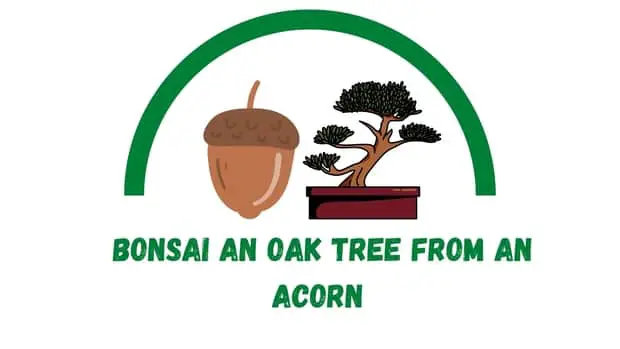
Oak trees are amongst the most popular tree species in the world, with well over 600 subspecies, such as English Oak, Pyrenees Oak, and Turkish Oak. With these trees being so popular globally, there is naturally a lot of crossover with people wanting to bonsai oak tree species. So, how exactly do you bonsai an oak tree from an acorn?
To bonsai, an oak tree from an acorn, plant a germinating acorn in perlite potting soil. Grow by watering, maintaining temperature, and protecting your seedlings during the winter. After a year, repot and train your seedling into a bonsai through trunk development, wiring, and pruning.
So, what are the advantages and disadvantages of keeping an oak tree bonsai? And what are the major differences between keeping an oak bonsai and other species? Keep reading to find out more!
Just a quick heads up, over the past three years of running Plantpaladin, hundreds of people have asked for product recommendations. As such, You can find my favorite indoor bonsai tree here (link takes you to Bonsaiboy), my favorite outdoor bonsai tree (link takes you to Bonsaiboy), or have a look at all the products I recommend here.
Bonsai An Oak Tree From An Acorn
Oak trees are incredibly popular.
With an estimated 600 species of oak trees, many want to add these trees to your bonsai collection.
That being said, unlike other tree species commonly used in bonsai, such as Olive, Juniper, Jade, or Scots Pine, Oak trees can be a little more difficult to grow.
Luckily, I contacted my local botanical gardens, spoke with a few bonsai experts, and even asked ten plant paladin readers who own Oak bonsai about the best method to grow an oak bonsai tree from acorns.
Here is what they said.
- Ensure it’s the right time of year
- Come up with a design
- Decide how large you want your tree to grow
- Pick your acorns
- Prepare your acorns for oak bonsai
- Invest in the right potting soil
- Plant your acorn in potting soil
- Maintain and care for your tree in the first year
- Move your tree into the right environment
- Repot your tree after one year
- Develop your trunk
- Wire your tree
- Prune the bonsai
- Repeat the process
Some of you will only be interested in some of the quick facts about oak bonsai which is why I have included the table below:
Oak bonsai care | Explained |
Water | Once per day in the summer, once per week in the winter. Only water if the soil is dry to touch. |
Sun | 4-6 hours of direct sunlight per day. |
Temperature | 10 to 84 degrees Fahrenheit (-12 and 29 degrees Celsius) |
Location | Outdoors in a birth sunny spot. Indoors with a LED grow light or near a window. |
Fertilizer | Once per month during the spring/summer |
Growth | 3 to 5 inches per year - slow growing. |
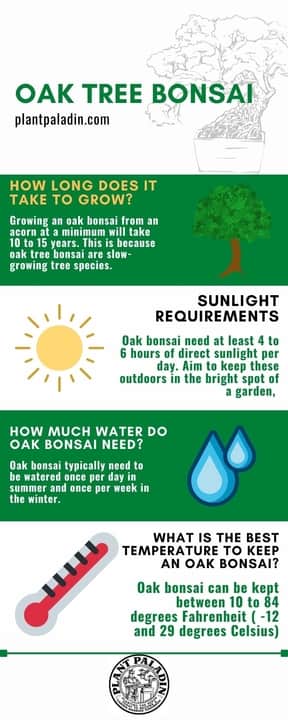
Let’s explore this in more detail below.
Ensure it’s the right time of year.
More than any other bonsai tree species, the time of year is one of the most important factors to mitigate when creating oak bonsai.
You see, training, pruning, and wiring the tree should all be undertaken as early in the spring as possible – to help the tree heal from these activities. Acorns can only be collected from oak trees in the fall for a few short weeks.
As such, these trees’ planting and growth process needs to be undertaken much later in the year than you would for other bonsai species.
Now, there are ways around this, with some reputable retailers selling acorns year-round; however, if growing an oak bonsai from scratch, where you want to source the acorns yourself, you will need to collect these in the fall.
Come up with a design.
One of the things I’ve struggled with on my bonsai journey has been growing out bonsai species without a style of bonsai tree in mind.
This leads to a lot of confusion, and it’s no surprise that my first few attempts at creating bonsai didn’t go down very well.
One of the best things you should consider when creating an oak bonsai tree from an acorn is to come up with a rough idea of the style and design of your tree.
Bonsai trees typically fall into several styles: upright formal/informal, cascade, semi-cascade, or sumo.
Having a plan of what style you want your tree to mimic and drawing this out on pen and paper as early as possible can save you years of heartache later on down the line.
You don’t have to commit to these styles this early and can always change them later on down the line, but this will make the whole design process a lot easier.
Decide how large you want your oak bonsai to grow.
Similar to the point above, it’s also important to note how large you want your tree to grow as early as possible.
Oak trees are relatively slow-growing, growing between 2 to 4 inches annually.
This means that growing a bonsai tree to a larger-sized classification for competitions, such as imperial, will take much longer than should you decide to opt for other species.
This will help set realistic expectations, and it will likely cause you to become frustrated when you are a few years into your oak tree bonsai project with only a very small tree.
Classification | Size inches | Size Centimeters | Hand Size | General Size |
Keshitsubo | 1 to 3 inches | 3 to 8 centimeters | Fingertip | Tiny |
Shito | 2 to 4 inches | 5 to 10 centimeters | One-hand | Tiny |
Mame | 2 to 6 inches | 5 to 15 centimeters | One-hand | Small |
Chohin | 5 to 8 inches | 13 to 20 centimeters | One-hand | Small |
Kumono | 6 to 10 inches | 15 to 25 centimeters | One-hand | Small |
Katade-mochi | 10 to 18 inches | 25 to 46 centimeters | Two-hand | Medium |
Chiu or Chumono | 16 to 36 inches | 41 to 91 centimeters | Two-hand | Medium |
Dai or Omono | 30 to 48 inches | 76 to 122 centimeters | Four-hand | Large |
Hachi-uye | 40 to 60 inches | 102 to 152 centimeters | Six-hand | Large |
Imperial | 60 to 80 inches | 152 to 203 centimeters | Eight-hand | Large |
Pick your acorns
Next up is one of the most important steps in growing an oak tree bonsai from an acorn – the picking process.
When to pick up acorns for oak bonsai
As mentioned earlier, first you must ensure it is the right time of year.
If acorns are picked too early in the year when they are not ripe, they will fail to germinate.
Alternatively, if these are picked too late in the year, there is a good chance that these acorns will have died.
The best time of year to pick acorns for Oak bonsai would be in mid to late fall. Picking acorns between September and November will give you the best chance of these acorns germinating, allowing them to be used for oak bonsai.
Should I pick acorns off the ground for oak bonsai?
Acorns that you will plant for bonsai use should not be picked off the ground but instead directly from oak trees. Acorns picked from the ground may have fallen weeks/months ago, meaning they can have a smaller chance of germinating.
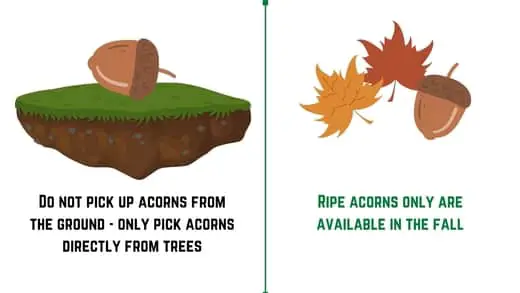
How many acorns should you pick for oak bonsai?
When picking acorns for creating oak bonsai trees, between 40 and 60 acorns should be picked from various trees. This is because many of the acorns you pick will either be dead or fail to germinate. The more acorns you pick, the higher the chance these acorns have of turning into viable seedlings.
Picking the acorns from different trees will give your acorns a stronger chance of survival.
If the tree fails to produce quality acorns, all the acorns from that one tree will be bad.
Some of these acorns will fail to grow; others will germinate and then fail to grow, so picking a larger amount will give you the best chances of success.
How to carry your acorns
When transporting acorns you have picked for bonsai use, keep them moist. Keeping acorns in a plastic bag or container sprayed with water thoroughly works best to ensure acorns do not dry out.
Sphagnum moss can also be used as a moisture holder for acorns, as it can hold up to 8 times its weight in water.
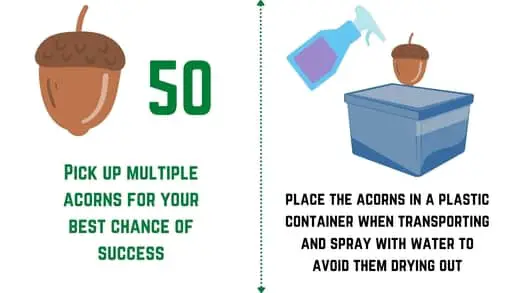
Prepare your acorns for oak bonsai.
Next up, we need to prepare the 40-60 acorns you have picked to be planted.
Whilst 40-60 might seem like a lot, the next steps will remove many of them from the process.
First, gather a bucket and pour your acorns in. Some cups the acorns have might fall off, but don’t worry, as these acorns can still germinate.
Then, fill the bucket with water; some acorns will float to the top.
These acorns are dead, and so need to be removed.
Once the rotten acorns have been removed, place the acorns in a see-through clear plastic bag or container box and place sphagnum moss at the bottom.

This will allow your acorns to have plenty of moisture while they germinate.
Then, cover this plastic bag/container with a dark plastic bag or container so no light can penetrate and the acorn does not dry out.
It is in the dark when acorns will start to germinate.
Store this away for about four weeks.
After four weeks, gently check the acorns every 3 to 4 days to see if they have started germinating.
Here, you are looking for any acorns that have sprouted their first root, about a quarter of an inch.
These acorns can then be potted in the next step.
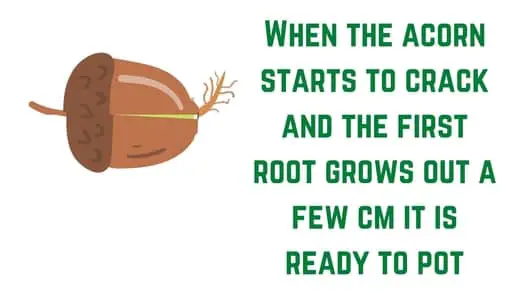
Invest in the right potting soil.
As your acorns are preparing to germinate in the containers, a good next step is to prepare the potting soil you will need for your oak tree bonsai.
Whilst most potting soils require three main elements: good aeration, drainage, and moisture retention, oak trees and acorns require more oxygen than other varieties.
Finding a granular soil mix works best for oak trees and bonsai varieties.
A potting soil mix containing a large percentage of perlite or vermiculite works best for growing oak bonsai trees.
A 100% soil mix of either vermiculite or perlite can produce fantastic results for oak varieties. However, for decent results, you can mix these soil mixes with others, such as volcanic ash rock or even peat moss and cactus soil.
Plant your acorn in potting soil.
At this point, your acorns will have started to sprout, and you will have chosen the right potting soil, so it is time to start planting your acorn.
First, choose a small pot around 3 to 5 (8 to 15 cm) inches deep.
Ensure that this has enough drainage holes – the larger the acorn and pot, the more drainage holes you will require – hopefully, the table below will help.
Size Classification | Size inches | Number of penny-sized holes | Number of pencil-sized holes |
Keshitsubo | 1 to 3 inches | 1-2 | 0 |
Shito | 2 to 4 inches | 1-2 | 0 |
Mame | 2 to 6 inches | 2 | 2 |
Chohin | 5 to 8 inches | 2 | 2 |
Kumono | 6 to 10 inches | 2 | 2 |
Katade-mochi | 10 to 18 inches | 2 | 3 |
Chiu or Chumono | 16 to 36 inches | 2 | 4 |
Dai or Omono | 30 to 48 inches | 3 | 6 |
Hachi-uye | 40 to 60 inches | 4 | 8 |
Imperial | 60 to 80 inches | 6 | 8 |
If you are tight on money, consider using an old yogurt pot and drilling a few holes in with a pencil at this stage. Don’t worry if your pot is too big; you will repot your plant in around a year or so.
Then, lightly fill the plant pot with a base layer of potting soil.
Place the acorn in the pot, ensuring that the new root points downwards – this will aid in the tree’s growth.
Then top up with the remainder of the potting soil. When potting your acorn, the topsoil should be around 1cm above the acorn.
Maintain and care for your tree in the first year
So once your acorn has been potted, you must ensure you give your seedling regular care in its first year.
We will cover watering, sunlight, and fertilizing requirements later in the post, but to summarize:
Watering – Your oak bonsai should be watered at least once per day. Ensure you touch the topsoil before watering. If the soil is still damp, avoid watering, which can cause overwatering.
Fertilizing – Avoid fertilizing your bonsai in its first year. Fertilizing can be undertaken in its second year, once monthly in the spring and summer.
Sunlight – Oak Bonsai requires 4-6 hours of direct sunlight daily. Use grow lights if kept indoors, or place them outside in a bright spot in your garden.
Problems in the first year of keeping oak bonsai
One of the major challenges you might have is that you will have planted your acorns in the fall when they are picked, and yet no growth will occur if you keep it outdoors due to winter.
As such, I found that keeping your bonsai tree indoors from the fall to the early spring and then moving it outdoors is the best bet for Oak bonsai.
To do this, move your bonsai tree indoors in a room where it can get plenty of light, such as on a window sill. Oak trees typically need around four hours of direct, unfiltered sunlight daily.
If your winters are particularly cold and harsh, invest in an LED grow light – you will want to ensure that this grow light covers the full spectrum of red and blue light.
LED grow lights should be kept about 10 inches away from your oak tree if using 50-watt bulbs. These lights should be kept on for about 4 to 6 hours in the winter.
Using grow lights in the harsh winters will prevent you from winterizing your bonsai in a very delicate stage and mimic the spring months, giving your bonsai continuous growth in the winter.
To read more on grow lights – check out my post on the best artificial light for bonsai here.
Move your tree into the right environment.
As soon as the early spring hits, you can move your tree outdoors in the first year to ensure it gets the best out of natural sunlight and temperature.
The best place to keep an oak tree bonsai would be in a bright spot in your garden where your tree can get 4-8 hours of sunlight daily.
Start by easing your bonsai in the shade for a few days per week and then gradually move into sunlight by the end of the week.
Ensure you keep the temperature of your oak tree bonsai between -12 and 29 degrees Celsius or 10 to 84 degrees Fahrenheit.
Temperature higher than 30 degrees C can dry out, burn, and kill your tree. Temperatures lower than -12C will freeze your tree to the point where it may not be able to recover.
If you live in a climate with extreme conditions, I’d consider investing in a bonsai greenhouse to maintain your tree’s temperature year-round.
Repot your tree after one year.
After one year, you will likely have a small oak tree that looks like a small, thin branch with a few leaves growing.
Sadly, this doesn’t resemble a bonsai, but the good news is after one year of solid growth, your tree should be healthy and robust enough for bonsai development.
Before you start developing your tree, it is time to repot your tree as the roots and tree will have outgrown the pot.
Now, repotting a tree is a large process all in itself, so I would recommend reading my full post on it here, but to summarise:
Remove your bonsai from its existing pot
Use a root hook to go around the edge of your existing pot to remove your bonsai.
This should loosen up the soil and make it easy to remove
Remove the taproot on the oak tree bonsai
So, one step that is unique to oak bonsai is taproots.
Taproots are centralized gnarly roots that other roots grow off of.
In an ideal world, bonsai tree roots will grow as follows:
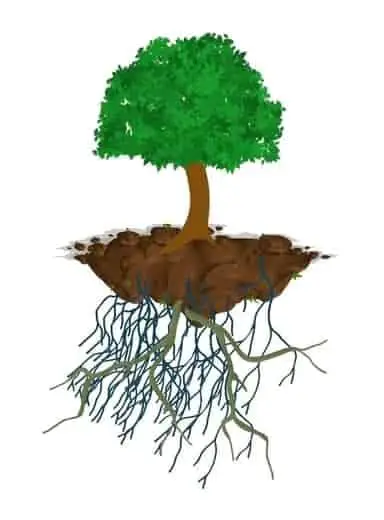
However, much root growth comes from one centralized tap root.
In oak tree species, taproots are notorious for being large and difficult to work with.
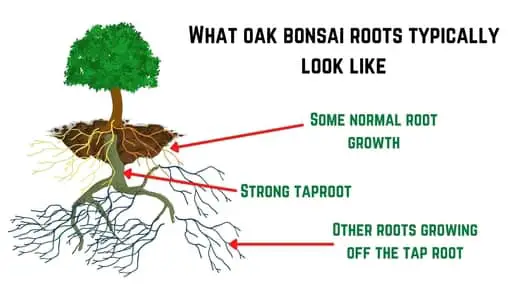
When keeping an oak bonsai tree, if we don’t trim down the taproot, any future roots will grow on the taproot instead of the bonsai base.
If you remove the taproot altogether, there might be insufficient roots for the tree to survive.
To counteract this, start by removing the clump of soil.
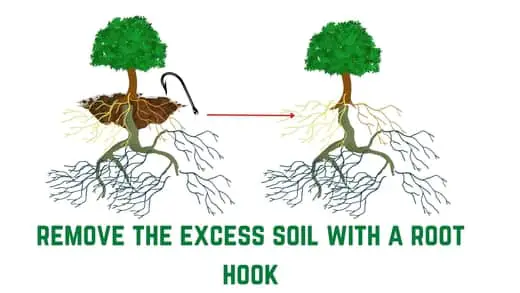
Then chop the taproot so you only have about 1cm remaining.
Ensure some root growth is above the taproot to prevent your bonsai from dying.
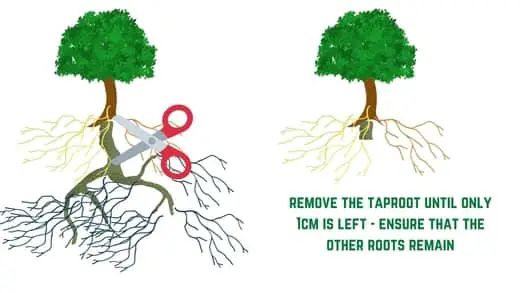
Finally, use a copper wire as a tourniquet and tie this around the top of the taproot.
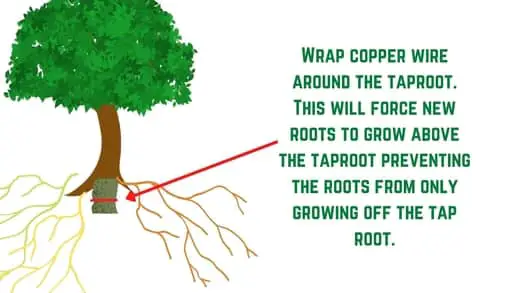
This will force the bonsai to create new roots above the taproot – when you remove the taproot, you can then.
Prepare your pot
Select a larger shallow bonsai pot.
You can use the table I highlighted earlier to get an idea of the number of holes you will need.
Apply a wire mesh at the bottom of the holes to prevent the soil from falling through.
Then thread two copper wires through the base holes/mesh – these should be about 15 to 30 cm long and be used to hold your bonsai tree in place.
Place your tree
Finally, add a quick base layer of potting soil, then gently place the oak tree bonsai in the new pot.
Finish off by tying the copper wire to the tree so it does not move, and then add the remainder of the potting soil to the top of the tree.
Your oak tree will be repotted and ready to start trunk development.
Develop your trunk
Now your oak tree bonsai has been repotted into a larger pot; you can start making it look like an actual bonsai tree.
The best palace to start with this would be by creating a wider, thicker tree trunk with plenty of movement and shape.
This can be undertaken in three main ways:
- Bonsai trunk chopping – used to add taper to your tree
- Bonsai trunk bending – used to add bends in your tree – particularly useful for styles like cascade, semi-cascade, or informal upright bonsai styles with a lot of movement.
- Growing out a sacrifice branch – This will thicken up the size of the tree’s trunk over a few years by growing out an excess branch.
Developing a thick, stylish, tapered bonsai trunk will transform your current oak tree into an oak bonsai. As this process can be challenging, I recommend looking at my bespoke post here.
Just be aware that developing a strong trunk for a slow-growing bonsai species such as oak can take 8 to 10 years if you grow your oak bonsai tree from an acorn.
Wire your tree
After a few years of tree trunk development, you will have a strong tree trunk resembling a bonsai tree.
Next up, we need to undertake the same process for the branches of your tree.
This is undertaken through wiring your bonsai – again, another complicated process that I have gone into more detail on here.
To wire your oak tree bonsai:
Remove any excess foliage from your tree to make it easier to see the branches you are wiring – this can be done with scissors.
Select the branches of your tree that can be single-wired, and then wrap copper or aluminum wire around the trunk of your tree at a 45-degree angle for support and then at a 45-degree angle around the branch you are wiring.
Single wire any secondary or tertiary branches.
For the remaining branches that are near each other, you can double-wire these.
Wrap your wire around the middle part of the trunk to reach multiple branches, then wrap the branches at a 45-degree angle.
You can then move your branches into their new position.
Remove the copper wire with shears after 6 to 8 weeks – your branches will then be set into their new position.
Prune the oak bonsai.
Once your oak bonsai tree has been wired, you can then prune the tree using a sharp pair of scissors.
Aim to cut back branches or leaves that take away from the silhouette of the tree design you are looking for.
Ensure you regularly check your tree every few weeks for signs of new growth and trim them back if need be.
Alternatively, if you want to speed up the rate at which your tree is sprouting leaves or enable new growth for a larger-sized bonsai, consider defoliating the leaves of your oak tree bonsai.
This will create a much thicker, denser canopy, leading to much greater bonsai ramification.
Repeat the process
Getting this far is only half the journey, and you will likely have to repeat the steps of repotting, developing the trunk, wiring, and pruning in a cycle every few years to achieve a bonsai you can be proud of.
As oak tree bonsai are so slow-growing, it can take upwards of 15 to 20 years until you have a decent-looking bonsai tree, so be patient.
Should you grow an oak bonsai from an acorn?
While a lot of this post talks about the exact steps you need to follow to grow an oak bonsai tree from an acorn, a question too many of us fail to ask ourselves is if we should.
You see, while oak bonsai trees are becoming more and more popular, one of the things that helped me when growing my oak bonsai from an acorn, was asking myself the following questions:
- How much time do you have to dedicate to this tree per week?
- Is growing the oak bonsai from an acorn essential, or can you make do with a young tree?
- How much experience do I have in growing bonsai?
- What happens if the acorn does not grow into the bonsai you want?
By asking yourself these questions just streamlines the whole process and will put things in perspective when growing your tree.
What are the best oak species for bonsai?
We discussed this earlier, but there are well over 600 species of oak tree that can be transformed into bonsai trees.
As such, what are a few of my favorite species for the transformation process?
Pin Oak
English Oak
Scarlet Oak
Konara Oak
Southern Live Oak
Bur Oak
Cork Oak
Sawtooth Oak
Growing an oak bonsai from an acorn – Video
While the instructions earlier are the exact steps I followed when growing my oak bonsai, I’m aware that some of you are visual learners.
As such, I just wanted to share a few videos that go into detail on how to grow an oak bonsai from an acorn:
FAQs on growing oak tree bonsai from an acorn
So now you know the exact step-by-step process of growing an oak tree bonsai from an acorn, there are several common questions you likely still have, so hopefully, the answers below will help:
How much water does oak bonsai need?
Oak bonsai typically needs to be watered once daily in summer and once weekly in the winter. Touch the topsoil of your oak bonsai. If dry to the touch, the tree needs to be watered. If moist to the touch, do not water as this can cause overwatering.
Sunlight requirements for Oak Bonsai
Oak bonsai need at least 4 to 6 hours of direct sunlight daily. Aim to keep these outdoors in the bright spot of a garden, indoors near a window, or with an LED grow light. Oak bonsai can also be grown in shady spots in the garden.
How to fertilize oak bonsai?
Oak bonsai should be fertilized once per month during the spring and summer. Oak bonsai should not be fertilized in the fall or winter. Do not fertilize an oak bonsai tree if it is less than one year old.
What is the best temperature to keep an Oak bonsai?
Oak bonsai can be kept between 10 to 84 degrees Fahrenheit (-12 and 29 degrees Celsius). Keeping oak bonsai in temperatures higher than this will cause them to dry out, burn and, in severe cases, die. Colder temperatures will cause your tree to freeze permanently.
Can you grow oak bonsai indoors?
Oak bonsai can be grown indoors if an LED grow light is used. Ensure the light is kept between 4 and 6 hours per day and 10 inches away from the tree if using a 50-watt bulb. Alternatively, keep the oak tree bonsai in a bright spot indoors, such as on or near a window sill.
Maintain the tree with watering, fertilizer, and pruning as you would normally.
How often should you repot an oak tree bonsai?
Oak bonsai can be repotted every 2 to 3 years. Avoid repotting oak tree bonsai every year. Do not repot oak tree bonsai within its first year. Older oak tree bonsai can be remitted every 5 to 7 years.
How long does it take to train an oak bonsai from an acorn?
Growing an oak bonsai from an acorn, at a minimum, will take 10 to 15 years. This is because oak tree bonsai are slow-growing tree species. Developing the tree through trunk development alone will take a few years.
What pests attack oak bonsai?
Aphids, spider mites, scales, slugs, and caterpillars are all common insects and pests that will commonly attack oak bonsai. Avoid insect infestation by using soapy liquid and vinegar.
To learn how to stop pests from attacking your bonsai, check out my post here.
Can I grow a bonsai from an acorn?
Acorns can be grown into oak tree bonsai. It takes about 15 years for acorns to mature into oak bonsai. Ensure you pick between 40 acorns to improve your chances of the acorns germinating. Keep acorns moist as you transport them, and ensure acorns are only picked from trees and not the ground.
Can oak be used for bonsai?
Oak trees can be used for bonsai trees. These bonsai are amongst some of the most popular varieties of bonsai. Oak bonsai can be grown from scratch with an acorn.
What is the best way to grow an oak tree bonsai from an acorn?
The best method to grow an oak tree bonsai from acorns is to select the right acorns. Ensure you choose at least 50 to ensure your acorn germinates. Pick acorns directly from the tree, not the ground, and transport them in a moist plastic bag to ensure they do not dry out.
Advantages of bonsai: an Oak tree from an acorn
The main advantages of oak tree bonsai are as follows:
- Strong trunks – Meaning that they are less likely to be susceptible to fungal or root infections
- Easy to grow – Acorns can be found anywhere, making them ideal for growing from scratch at an inexpensive price.
- Long-lasting – As these trees are slow-growing, they can last hundreds of years, passed down from generation to generation.
Disadvantages of bonsai an Oak tree from an acorn
Oaktree bonsai also has a few significant downsides, including:
- Slow growing – These trees only grow between 2 and 5 inches per year, meaning it can take decades to mature bonsai trees.
- Harder to train – Oaks agave strong wood, meaning that the branches and roots will be more challenging to maintain and manage than in other varieties
- Taproot – Oak trees are notorious for having strong taproots. Failing to remove these correctly can kill your oak bonsai during repotting.
How do you know when an acorn is ready to plant?
So, we covered this briefly earlier, but how exactly do you know when your acorns are ready to plant for your oak bonsai?
Acorns will be ready to plant when they have sprouted their first root, and this root grows to about a quarter of an inch thick. Roots generally occur after about four weeks of keeping the acorns in a dark space away from light.
Is creating an oak bonsai from acorns difficult?
Creating and growing an oak bonsai from an acorn will be more challenging than growing it from a cutting or small tree.
This is because growing out and germinating acorns is a small project that can add layers of complexity to the process that most bonsai owners don’t have to worry about.
As such, if this is your fist time growing an oak bonsai, you learn the basics of growing an oak tree and a bonsai tree before trying to grow one form an acorn. Growing an oak bonsai from an acorn cal also be challenging simply due to the sheer amount of time this can take to complete.
Study on bonsai, an oak tree from an acorn
Finally, I surveyed ten plant paladin readers who own oak bonsai and asked them if they were easy to grow.
Here are the results:
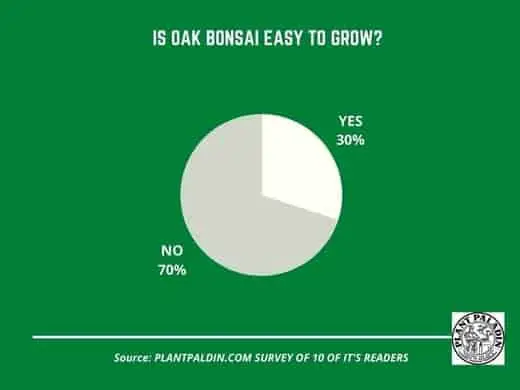
My top picks for the gear you will need!
So like I mentioned earlier, over the past three years of running PlantPaladin, hundreds of people have asked me for my recommendations on the best bonsai gear on the market.
Having spent thousands of dollars on bonsai items these past few years and tested at least 100 bonsai-specific products, I’ve listed my favorite products below – All of which I highly recommend and think you can get great value.
They can purchase directly by clicking the link to take them to Amazon.
Bonsai Tool Set: One of the significant challenges I’ve had is finding a toolset that was not only durable but didn’t break the bank. SOLIGT has recently developed a fantastic bonsai tool set that covers all the tools you need to trim, prune, and repot your trees. – You can grab it here.
Complete Bonsai Set: Many of you will want to grow your bonsai trees entirely from scratch, but finding the varicose seeds, pots, and other items in one place can be challenging. Leaves and Sole then have created a complete bonsai set that I’ve personally used that ticks all the boxes. You can grab it here.
Bonsai wire: The number of times I’ve run out of wire for my bonsai or purchased cheap bonsai wire that doesn’t do the job is embarrassing for me to admit. After a lot of trial and error, I found that using Hotop’s aluminum bonsai wire is one of the best options on the market. This can easily be used for both indoor and outdoor bonsai. You can grab it here.
This post was written by Fehed Nicass who has been passionate about bonsai for over 3 years.
